250+ Basketball Terms all Coaches and Players Must Know
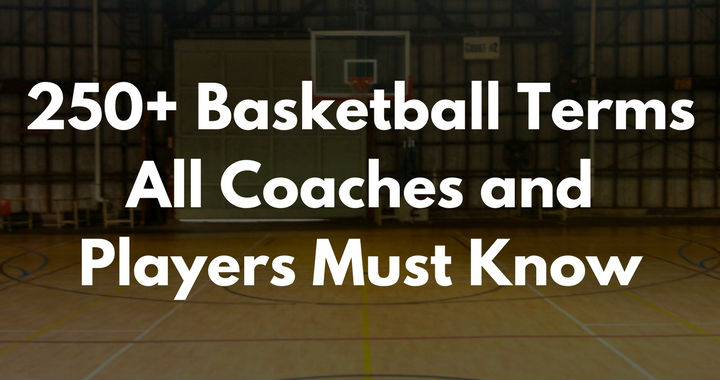

Becoming familiar with the many different basketball terms is one of the toughest challenges for all new coaches and players.
There are a lot of them…
From learning the many different offenses and defenses (examples: 5-out motion and 1-3-1 defense) to the many rule violations (examples: 5-second violation and cross-court violation), there is a lot of basketball terminology to take in.
Below, I’ve listed 250+ of the most common basketball terms you will hear during a basketball practice or game.
Don’t expect to learn all these at once.
Rather, whenever you hear a word or phrase you’re unsure of, return to this page to find out what it means and how you can learn more.
Let’s get started…
FREE DOWNLOAD: The 3 best shooting drills ever created (Click to download).
250+ Basketball Terms You Must Know
— 1, 2, 3 —
1-2-1-1 Press – A true full-court press with many possible variations. The goal of the press is to trap the basketball immediately after it has been inbounded into play. This allows the defense a lot of time to recover if the offensive team is able to break the press.
1-2-2 Zone – A common zone defense similar to a 2-3 zone. This zone defense starts with a player at the top of the key, a player on each elbow, and a player on each low block. All 5 players are responsible for guarding a portion of the three-point line.
1-3-1 Zone – A unique and aggressive zone defense that relies on cutting off passing lanes, anticipation, and deflections to create turnovers and fast break opportunities for your team.
2-3 Zone – The 2-3 zone is the most common zone defense coaches will use as an alternative to man-to-man defense. It involves two players at the top of the key guarding above the free-throw line and three players across the key guarding the paint and the sides of the court. This is a very common defense to see in youth basketball (unfortunately) because it crowds the key and forces the opposition to shoot from the perimeter.
3-2 Zone – The 3-2 zone is a common zone defense. It involves three players guarding the perimeter and two players inside guarding the key area. This defense is great for challenging perimeter shots, but can be exposed inside due to only two defenders protecting the basket.
3-Second Violation – An offensive player will be called for a 3-second violation when they spend more than three seconds in the key while the basketball is in live play.
4-Out 1-In Motion – The 4-out 1-in motion offense involves three players spread out around the perimeter while one player occupies the low post. A positionless, continuity offense.
5-Out Motion – The 5-out motion offense involves five players spread out around the perimeter. It’s a positionless, continuity offense that’s great for player development at any level.
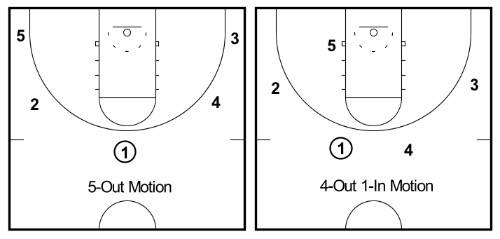
5-Second Violation (inbound) – Once a player inbounding the basketball has taken possession from the referee, they then have 5 seconds to inbound the basketball to a teammate or they’ll be whistled for a 5-second violation.
5-Second Violation (closely guarded) – An offensive player in the frontcourt with possession of the basketball can be called for a 5-second violation if they’re being guarded within 6 feet and fail to pass, shoot, or dribble within 5 seconds.
8-Second Backcourt Violation – After a team gains possession in the backcourt, they then have 8 seconds to advance the basketball over the half-way line. If they fail to do so, a violation will be called.
— A —
Airball – A shot attempt that doesn’t hit the rim or the backboard.
Alley-Oop – An exciting play involving a player catching a pass in the air and finishing with a layup or dunk before landing back on the court.
Amoeba Defense – A junk defense made popular by coach Jerry Tarkanian at UNLV. Similar to the 1-3-1 zone, the Amoeba defense is designed to confuse the opponent and force turnovers.
And One – A phrase used when a player gets fouled on a made shot attempt. The player then gets to go to the free-throw line and shoot one bonus free-throw.
Ankle Breaker – When an offensive player uses a dribbling move that results in the on-ball defender stumbling or falling down.
Assist – A player is awarded an assist when they make a pass that leads directly to a score by one of their teammates.
— B —
Backboard – A rectangular board generally made of tempered glass that the rim is attached to. The backboard prevents most missed shots from going out-of-bounds and provides a wall the players can shoot the basketball off and into the basket.
Backcourt (area) – If referring to an area of the court, the backcourt is the half of the court that a team is defending.
Backcourt (players) – The term backcourt can also be used to refer to the two guards on a team. The point guard and the shooting guard.
Backcourt Violation – See ‘cross-court violation’.
Backdoor Cut – An offensive play involving a player cutting behind their defender towards the rim looking to receive a pass and finish with a score. This play is often encouraged by coaches when a player’s opponent is overplaying the passing lane.
Back Screen – An offensive play involving an off-ball player setting a screen on the back of a teammate’s defender. The screener’s teammate will then cut towards the hoop looking to receive a pass and finish at the basket.
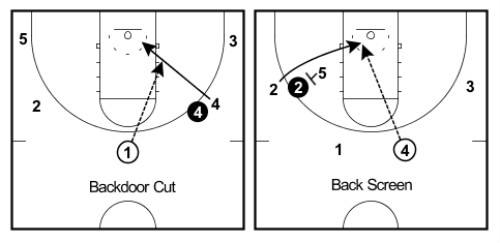
Balance Hand – The non-shooting hand when going through the process of taking a shot. The role of this hand is to balance the basketball on the shooting hand until the basketball is about to be released.
Ball Fake – See ‘pass fake’.
Ball-Handler – Any player dribbling the basketball can be referred to as the ball-handler. Although many coaches will use this term when referring to the point guard.
Ball Side – Refer to ‘strong side’.
Ball Reversal – The term used when a basketball starts on one side of the court and is then passed to the other side of the court. Coaches utilize ball reversals to move the defense.
Bank Shot – A shot that bounces off the backboard before falling through the basket.
Baseball Pass – A one-handed pass commonly used to throw a full-court pass to a teammate sprinting down the court. This type of pass will be more powerful than a chest pass but much less accurate.
Baseline – The line separating the playing area from out-of-bounds four feet behind the backboard. Also known as the ‘endline’.
Basket (equipment) – A circular hoop with a diameter of 18 inches that’s attached to the backboard. A team must pass the basketball through top of this hoop to score points.
Basket (score) – The term ‘basket’ can used when a player successfully scores a field goal.
Basket Cut – An offensive action involving a player making an explosive cut directly towards the hoop.
BEEF – An acronym used often by coaches teaching players how to shoot with correct technique for the first time. B = Balance. E = Eyes. E = Elbow. F = Follow through.
Behind-the-Back Dribble – An advanced dribbling move involving a player moving the basketball from one hand to the other by bouncing it behind their back. Often used when a close on-ball defender would steal a basic crossover.
Behind-the-Back Pass – An advanced pass involving the player with the basketball passing to a teammate by wrapping the ball behind their body.
Bench – The sitting area for the coaches and players who aren’t currently on the court. Both team’s benches are located on the sideline at opposite ends of the court.
Bench Points – The number of points scored by all players on a team who started the game on the bench.
BFC – The acronym for the Basketball For Coaches website. The only website you need for everything about coaching basketball (shameless plug).
Big Man – A coach will often use the term ‘big man’ when referring to one of the taller players on the team. Usually the center or the power forward.
BLOB – The acronym for a BaseLine Out of Bounds play. These are plays designed to be used when the offense is passing the basketball into play from the offensive baseline.
Block (defensive play) – The term block can be used when a defensive player knocks the basketball out of their opponent’s hands or out of the air during an attempted field goal.
Block (foul) – A player can be called for a blocking foul if they impede an offensive players path without having established legal defensive position.
Block (court area) – There are two small rectangles located on the outside of the key that coaches will refer to as the block.
Board – See ‘rebound’.
Bounce Pass – A pass that is intentionally rebounded off the floor before reaching the receiver. Players are generally taught to aim at the area of the floor 2/3 of the way to their teammate.
Box Out – After a shot has been taken, coaches will encourage their players to box out. This means making contact with the player they’re guarding and establishing position between them and the basket to put themselves in the best position to secure a rebound.
Box and One – A defensive strategy commonly used against teams with one dominant player. This defense involves playing one defender man-on-man against the dominant offensive player and then setting up the four other defenders in a box zone.
Brick – A slang word given to a poor shot attempt that bounces hard off the rim or the backboard.
Buzzer Beater – A shot attempted in the final seconds and made after the shot clock has expired. The points will still count since the basketball left the shooter’s hands before the clock expired.
— C —
Carry – A carry is a dribbling violation that occurs when a player continues their dribble after placing their hand underneath the basketball.
Center – Also known as the ‘5’. The tallest player on the team is often referred to as the ‘center’. This player’s main responsibilities are to secure rebounds and defend the paint.
Center Court – The circle in the middle of the court where the jump ball takes place at the start of every basketball game.
Charge – An offensive foul that’s called when an offensive player runs into a defender who has established position.
Charity Stripe – See ‘free-throw line’.
Cherry Picking – People will use the term ‘cherry picking’ when a player who is meant to be helping their team on defense hangs around the half-way line or the opponent’s goal waiting for a long outlet pass that leads to an open layup or dunk.
Chest Pass – This is the most common type of pass and involves one offensive player making a two-hand pass from their chest to the chest of another offensive player without the basketball touching the ground.
Closeout – A closeout is a defensive action that occurs when an offensive player receives the basketball and their defender must sprint towards them to prevent the shot while also attempting to prevent the offense from driving towards the hoop.
Corner – The corner is the small area of the court where the sideline meets the baseline. There are often many three-point shots taken from this spot as it’s an important area to fill for team who want great spacing.
Court Vision – The term ‘court vision’ is used when a player has great ability to read the play. Usually goes hand-in-hand with basketball IQ.
Cross-Court Violation – When the offensive team establishes possession of the basketball in the frontcourt, they are then not allowed to return to the backcourt while still in possession of the basketball. If they do, a cross-court violation will be called.
Cross Screen – A cross screen occurs when a player cuts to the opposite side of the floor to set a screen for a teammate. This most often occurs in the paint.
Crossover – A dribbling move involving a player passing the basketball from in front of their body from one hand to the other. This is the most common dribbling move and is great for quickly changing directions.
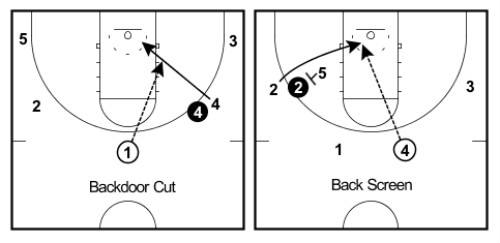
Curl Cut – A curl cut occurs when a player who receives an off-ball screen uses the screen and cuts towards the basket. This is a great action for an offensive player when the defender follows them over the screen.
Cut – A quick sprint that can involve changing directions made by a player in an attempt to get themselves free to receive a pass or clear out space for a teammate.
— D —
Dagger – A slang term that can be used to describe a clutch shot made in the final few seconds of the shot clock or the game.
Defense – The team on defense is the team without possession of the basketball. While on defense, the team will attempt to prevent the opposition from scoring in their basket.
Defensive Stance – The players on defense should always be in defensive stance. This involves keeping the knees bent and arms out wide. This puts a defender in the best position to react quickly and steal the basketball.
Deflection – When a defender makes contact with the basketball but doesn’t get the steal, it is referred to as a deflection.
Diamond and One – A junk defense similar to the box and one. It involves one player guarding the opposition’s best player man-to-man and the other four defenders set up in a diamond zone.
Diamond Press – See ‘1-2-1-1 press’.
Dip – The process of bringing the basketball down to a lower starting point before shooting. Dipping the basketball allows players to have a consistent starting point and also adds power and momentum to the shot.
Dish – See ‘assist’.
Double-Double – The word ‘double-double’ is used when a player scores in double-digits in two positive statistical categories. For example, 16 points and 10 assists.
Double Dribble – This is a dribbling violation that occurs when a player dribbles the basketball with two hands simultaneously or terminates their dribble and then begins to dribble again.
Double Foul – An uncommon situation that occurs when two opponents commit a foul against each other at the same time.
Double Screen – When two off-ball offensive players set a screen side-by-side. This increases the distance the cutter’s defender has to move to avoid the screen which will give the offensive player who received the screen extra time to make a play.
Double Team – A double team occurs when two defensive players trap the player in possession of the basketball. The goal is to get the basketball out of a great player’s hands or force the offensive player to make a poor pass that results in a steal.
Down Screen – A down screen is any screen that’s set when when the screener has their chest facing the baseline. This results in their teammate cutting away from the hoop which is why it’s often used to get shooters open.
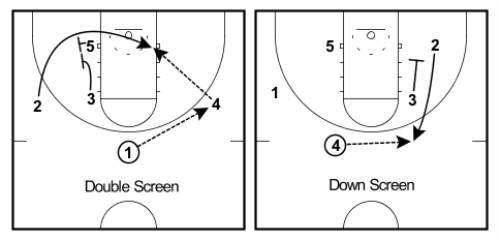
Dr. James Naismith – The amazing man who first invented basketball back in January 1892. Thanks, Doc!
Drag Screen – A drag screen is an on-ball screen set by a trailing offensive player. This screen is often effective because the screener’s defender is out of position and unable to provide help on the ball-handler.
Dribbling – The process of using one hand to repeatedly bounce the basketball off the floor. This is the only legal way a player can move around the court while in possession of the basketball.
Dribble Drive Motion – A motion offense developed by Vance Walberg. The offense is designed to spread the floor and focuses on dribble penetration for a layup or passing out to a teammate for an open shot.
Drive and Kick – An offensive action involving a player penetrating the defense to force them to shift and then passing out to a teammate on the perimeter.
Drop Step – An offensive low post move involving the player with the basketball and their back to the basket taking a large step back and to the side of their defender as they turn towards the basket to create room for a shot.
Dunk – A dunk is an exciting play involving an offensive player slamming the basketball forcefully through the hoop.
— E —
Elbow – The ‘elbow’ is the area on the court where the lane line and the free-throw line meet. There are four elbows on a full basketball court.
Elevator Screen – An elevator screen is a screen set by two players and involves the player being screened cutting through the middle and then the two screeners closing the screen by quickly stepping side-by-side.
Endline – See ‘baseline’.
EuroLeague – The top basketball league in Europe. The league contains 16 teams who each play each other once for a total of 30 games before finals.
Euro Step – The euro step is an advanced move used when attacking the basket. It involves a player taking a step in one direction and then taking a step in another direction for their second step before finishing at the rim.
— F —
Face Up – See ‘square up’.
Fadeaway – A basketball shot can be referred to as a ‘fadeaway’ when the shot is taken while the player is jumping away from the basket. This shot requires a high level of skill and is used to create space between the shooter and their defender.
Fast Break – After a change of possession, a team advances the basketball as quickly as possible to attack the defense before they have been able to establish good defensive position.
FIBA – FIBA is the acronym for ‘Fédération Internationale de Basketball Amateur’ which is in charge of all international basketball competition.
Field Goal – A field goal is a shot made from anywhere on the court except for free-throws. This includes both two-point shots and three-point shots.
Finger Roll – The finger roll is an advanced variation of a layup that involves a player turning their palm up and rolling the basketball of the tips of their fingers. This can create a ‘soft’ layup and also allow the shooter to finish with arc that negates a shot block attempt.
Flagrant Foul – A foul involving contact that the referee deems to be intentional, excessive, or unnecessary. The team who draws the flagrant foul will receive two free-throws and possession of the basketball.
Flare Screen – A flare screen is an off-ball screen that allows a player to cut away from the basketball to a spot around the perimeter. Similar to a back screen.
Flash – An quick offensive cut across the paint towards the basketball. Most effective when a player can catch the defense off guard.
Flex (cut) – The flex is a cross screen immediately followed by a down screen. This is a very common and effective action at all levels of basketball.
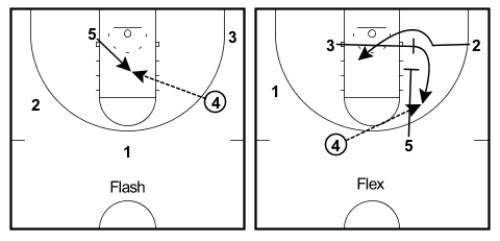
Flex (offense) – The flex offense is a continuity offense requiring great spacing and smart players. This offense can be great for development as all 5 players must fill all 5 positions.
Floater – A type of shot often utilized by smaller guards to score at the rim against tall defenders. The basketball is shot with a high arc to prevent a blocked shot.
Flop – When a player intentionally falls or stumbles to appear to have been fouled by an opponent, we call it a ‘flop’. This can be done by both defensive and offensive players.
Floppy – A basketball play often used for great shooters. Involves the shooter starting under the rim with a single screen on one side and a staggered screen on the other. The shooter can choose which side to cut on.
Four High – A basketball formation involving a player on each wing, a player on each elbow, and a player with the basketball at the top of the key.
Four Low – A basketball formation involving a player in each corner, a player on each low block, and a player with the basketball at the top of the key.
Foul – A violation of the rules usually involving illegal contact with a player of the opposition.
Foul Line – See ‘free-throw line’.
Foul Shot – See ‘free-throw’.
Four-Point Play – A four-point play is a rare event that occurs when a player is fouled while successfully making a three-point shot and then makes their bonus free-throw.
Four Corners Offense – A delay offense used by teams before the shot clock was added to the game of basketball. It involves one player with the basketball in the middle of the court attempting to break down their defender while their teammates stand in the corners.
Free-Throw – An uncontested shot 15 feet from the basket directly in front. Most free-throws are awarded to players who have been fouled while shooting. Each free-throw is worth one point.
Free-Throw Line – The free-throw line is 12 feet in length and located 15 feet from the basket. This is the line that players stand behind to shoot free-throws.
Free-Throw Line Extended – This is an imaginary line that extends the free-throw line to the sideline. Coaches will often refer to free-throw line extended when discussing offense or defense.
Frontcourt (area) – If referring to an area of the court, the frontcourt is the half of the court in which a team attempts to score.
Frontcourt (players) – The term frontcourt can also be used to refer to the two forwards and the center on a team. The small forward, power forward, and center.
Full-Court Press – A defensive strategy involving the defense pressuring the basketball for the entire length of the court. A full-court press can be either man-to-man or zone. For example, the 1-2-1-1 press.
Jump Ball – See ‘tip off’.
— G —
Give and Go – An offensive play involving the player with the basketball making a pass to a teammate and then cutting towards the rim and receiving a return pass.
Goal Tending – A goal tending violation is called when a player on defense touches the basketball when it’s on the downward flight after a shot. When this happens, the basket is counted. A goal tending violation is also called if a player touches the basketball while it’s above or on the rim.
Grinnell Offense – A unique offensive strategy developed by coach Dave Arseneault at Grinnell College. It’s a high-pace and high-scoring offense usually involving the offense attempting a three-point shot within the first 5 – 7 seconds of the shot clock.
Guide Hand – See ‘balance hand’.
— H —
Hack – The term ‘hack’ is another word for fouling an opponent.
Hack-a-Shaq – A defensive strategy involving a team intentionally fouling the opposition’s worst free-throw shooter and sending them to the line.
Half-Court Line – The line through the middle of the basketball court and the center court that divides the basketball court into two halves.
Hammer – A back screen set on the weak side of the court that allows a teammate to cut to the corner for an open shot. Made common NBA play that was first made popular by the San Antonio Spurs.
Hand-Off – An offensive action involving one player handing the basketball to a teammate.
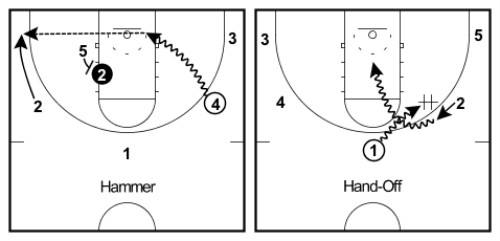
Hedge – A ‘hedge’ is a common pick-and-roll defense. It involves the screener’s defender stepping out to meet the ball-handler and force them to dribble wide while the on-ball defender recovers.
Help Side – Refer to ‘weak side’.
Hesitation Dribble – An advanced dribbling move involving the ball-handler quickly slowing down and then exploding past their defender.
Hook Shot – A one-handed shot involving the player with the basketball turning side on to the basket and then extending their shooting arm and flicking the basketball over their head towards the basket. A very difficult shot to block.
Hoop – Refer to ‘basket (equipment)’.
— I —
Illegal Screen – Any player who sets a screen must be stationary when the defender they’re screening makes contact with them. If they’re not, an illegal screen will be called.
In-and-Out Dribble – A dribbling move involving a player pretending to perform a crossover dribble but only starting the inward motion before bringing the basketball back out to the original side.
Inbounds Pass – The basketball term ‘inbounds pass’ is used when a player on offense passes the basketball into the court from out-of-bounds.
Intentional Foul – A foul involving a defensive player making deliberate contact with a player of the opposition team.
Isolation – An offensive tactic involving one player with the basketball being left alone on one side of the court while their teammates clear out to the other side of the court. This is often used when a player has a favourable one-on-one matchup.
— J —
Jab Step – From triple threat position, a player takes a quick step towards the basket while keeping their pivot foot planted. The jab step is used to see how the defense will react and possibly create an advantage for the offensive player.
Jump Ball – Used to start every basketball game. Involves the referee throwing the basketball up in the center of the court between two players who jump and attempt to tap the basketball to a teammate.
Jump Shot – A shot taken by jumping up in the air and releasing the basketball at the peak of the jump.
Jump Stop – A jump stop is used to come to a complete stop after dribbling or after receiving a pass. It involves both feet hitting the floor simultaneously.
Junk Defense – A junk defense is a combination of man-to-man defense and a zone defense. For example, a box and one or a triangle and two.
— K —
Key – The rectangular area under the basket and the free-throw circle. Originally referred to as the ‘key’ because the lane lines were closer together than the width of the free-throw circle which gave off the appearance of a key hole.
— L —
L-Cut – A cut made in the shape of an ‘L’. Usually from the low block up the lane line to the elbow and then cutting out to the wing. Some coaches use the term ‘L-Cut’ when referring to cutting around the perimeter, too.
Lane – See ‘paint’.
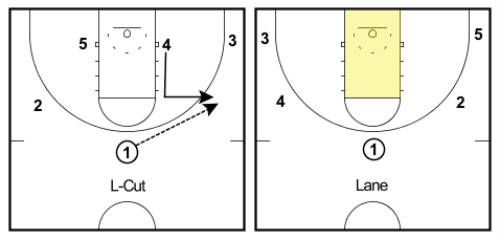
Lane Violation – A lane violation can be called on either the offensive or defensive team and occur during free-throw situations. Any player who steps over the lane line before the basketball has left the shooter’s hands will be called for a violation.
Layup – A close-range shot taken when attacking the basket. Usually involves the shooter banking the basketball off the backboard.
— M —
Man-to-Man Defense – A defense that involves all players matching up and taking responsibility of guarding one player on the opposition team. It is a team defense and players are required to help each other, but all players have a specific opponent they’re defending.
Midrange – A midrange is a jump-shot that’s taken anywhere between the three-point line and the key area. This shot is worth two points.
Mid-Court Line – See ‘half-court line’.
Mismatch – When an offensive player has an advantage over the defender that’s currently guarding them. When this happens, the offense will usually look to isolate this matchup on the wing or in the low post.
Mover Blocker Offense – This offense was developed by coach Dick Bennett. In this offense, some players are ‘movers’ (scorers) and some players are ‘blockers’ (screeners).
Moving Screen – See ‘illegal screen’.
— N —
NBA – The National Basketball Association is a professional basketball league located in North America. The league consists of 30 teams and features many of the best basketball players on the planet.
NCAA – The acronym for the National Collegiate Athletic Association. A non-profit organization in charge of all college sports.
NFHS – The acronym for the National Federation of State High School Associations. In charge of writing the competition rules for all high shool sports.
No-Look Pass – This is an advanced pass that involves the player with the basketball looking one direction and pass another direction. This highlight play is designed to trick the defense.
— O —
Offense – The team on offense is the team with possession of the basketball. While on offense, the team will attempt to score in their opponent’s basket.
Officials – The people in charge of keeping the game under control and enforcing the rules of the game.
On-Ball Defense – When an offensive player has the basketball, the defender guarding them and pressuring the basketball is playing on-ball defense.
One-Pass Away – Coaches will use the term ‘one-pass away’ when they’re speaking about team defense. A defender one-pass away is defending the player next to the basketball.
Open Post – The term used when there are no offensive players attempting to post up on the low block. When most coaches talk about open post, they’re referring to the 5-out motion.
Outlet Pass – After a defensive rebound, the immediate pass to a teammate to start a fast break is called an outlet pass.
Overhead Pass – An overhead pass is a two-handed pass made from above the head of an offensive player. This pass is effective for passing over the top of the defense.
Overtime – If a game is tied after the end of regulation, teams will often play a 5-minute overtime period to determine a winner.
Over-and-Back Violation – See ‘cross-court violation’.
— P —
Pack Line Defense – A popular variation of man-to-man defense developed by Dick Bennett. It involves one player defending the basketball at all times while the other four players are in help position inside an imaginary arc 16 feet around the basket. Complete coaching guide here.
Paint – The rectangular area located below the hoop that extends to the free-throw line. This area is usually painted a different colour to the rest of the basketball court which is where it gets its name.
Palming – See ‘carry’.
Pass Fake – A quick movement where a player pretends to pass to a teammate by looking at them and making a quick passing motion while keeping hold of the basketball.
Passing Lane – An imaginary line between two offensive players that the basketball would follow if a pass was thrown.
Penetration – Penetrating is when an offensive player is able to dribble towards the basket through the defense.
Pick – See ‘screen’.
Pick-and-Pop – Similar to the pick-and-roll. An offensive player will set a screen for the player in possession of the basketball. But instead of rolling towards the hoop, the screener steps out to the perimeter and looks to receive a pass for an open shot.
Pick-and-Roll – A common and effective two-person offensive action involving an offensive player setting a screen for the player in possession of the basketball. The screener will then roll towards the basket looking to receive a pass from the ball-handler.
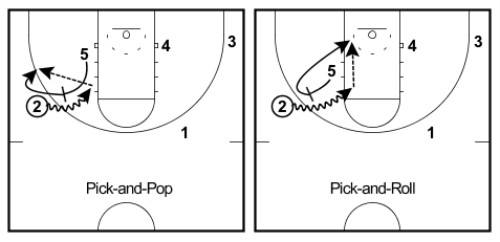
Pick-and-Slip – Another variation of the pick-and-roll. In this variation, just before the screener is about to screen the on-ball defender, they instead slip towards the basket looking to receive a pass and finish at the rim.
Pinch Post – Pinch post is an action that occurs when the basketball is passed to the weak side elbow while there are no other players on that side of the floor.
Pivot – When a stationary player has possession of the basketball, they’re allowed to move one foot around as long as their other foot stays in contact with the floor at all times. This is called pivoting.
Pivot Foot – The foot that stay in contact with the floor while a player is pivoting is known as the pivot foot.
Playmaker – A player is referred to as a ‘playmaker’ when they have the ability to create open shots for their teammates or give them an advantage on offense to score. Usually the point guard.
Point Guard – Also known as the ‘1’. One of the five positions on the court. The point guard is usually tasked with dribbling the basketball up the court, initiating the offense, and controlling the tempo of the game.
Possession Arrow – Usually a wooden or plastic arrow that sits on the scorer’s table. Many leagues use a possession arrow to determine who starts each quarter with the basketball and who takes possession when a jump ball is called.
Post Up – A player posts up by establishing position close to the ring (usually on the low block) with their back to the basket and their chest facing the perimeter ready to receive a pass.
Posterize – A slang term used when an offensive player makes a highlight dunk over an opposition player.
Power Forward – Also known as the ‘4’. One of the 5 positions on the court. Traditionally, the power forward plays very similar to the center by playing in the post and rebounding the basketball. In today’s game, we’re seeing less post play and more outside shooting from this position.
Press – An organised basketball defense in which the team on defense pressures the opponent full-court in an attempt to force a turnover.
Pump Fake – See ‘shot fake’.
Put Back – When a player on the offensive team grabs an offensive rebound and then immediately scores a field goal in the paint.
— Q —
Quadruple-Double – A rare stat line where a player reaches double-digits in four offensive categories. For example, 15 points, 12 rebounds, 11 assists, and 13 steals.
Quintuple-Double – The near-impossible stat line of reaching double-digits in five offensive categories. For example, 18 points, 14 rebounds, 11 assists, 12 steals, and 10 blocks. This has never happened in the NBA.
— R —
Ram Screen – Coaches will use the term ‘ram screen’ when an off-ball screen is set that leads directly into an on-ball screen. This is an effective action because it’s very difficult for the screener’s defender to get back in position quickly to play help defense.
Read and React Offense – Developed by Rick Torbett, the Read and React offense is a positionless, continuity offense that allows players to read the defense and make decisions.
Rebound – A ‘rebound’ is a stat that’s awarded to the player who gains possession the basketball after a missed field goal attempt. A rebound can be either offensive (rebound by a player on offense) or defensive (rebound by a player on defense).
Referees – See ‘officials’.
Restricted Area – A semi-circle inside the paint and four feet around the basket. A defensive player cannot take a charge while their feet are inside this area. Its purpose is to ensure that the offensive player has somewhere to land when attacking the basket.
Run-and-Jump Defense – The Run-and-Jump defense (or R&J) is a full-court man-to-man press with rules that encourage jump-switching and trapping. It was first created by Dean Smith at North Carolina during the 1970’s. This full-court defense is best suited for a team of athletes that want to play an uptempo style game.
— S —
Scorekeeper – An official responsible for filling out a scoresheet throughout the game. This requires them to keep track of points scored, fouls, and timeouts.
Screen – A screen involves a player setting a stationary block on their teammate’s defender. The goal of a screen is to give their teammate space that may lead to an open shot or simply to receive a pass that puts them at an advantage.
Screen-the-Screener – A term used when a player receives a screen from a teammate immediately after setting a screen for another teammate. This is a very difficult action for the defense to guard.
Scrimmage – The term used for an unofficial game of 5-on-5. Scrimmages are most often ran towards the end of practices and involve players on the same team competing against each other.
Shooting Guard – Also known as the ‘2’. One of the 5 positions on the court. This player is usually the team’s best shooter from the perimeter.
Shooting Range – A player’s shooting range is the maximum distance away from the hoop that the player can consistently make shots.
Short Corner – An area of the basketball court between the corner and low block. While there’s nothing to mark this area, it’s an advantageous spot for the offense to occupy especially against zone defense.
Shot Clock – A shot clock is an electronic countdown timer used to increase the pace of a basketball game. The timer is usually set at 24 – 35 seconds in length and the team on offense must attempt a field goal before the shot clock expires.
Shot Clock Violation – If a team is unable to attempt a shot before the shot clock expires, a shot clock violation is called and the offensive team loses possession of the basketball.
Shot Fake – An advanced move where the player in possession of the basketball pretends to shoot. This move is designed to trick the defense and get them to raise out of their stance or jump which will then put the offensive player at an advantage to dribble past them.
Sideline – The boundary lines that separate the playing area from out-of-bounds on the side of the court.
Sixth Man – A player who starts the game on the bench but is the first player to substitute on court and replace a starter.
Skip Pass – A pass made over the defense from one side of the court to the other. For example, from the corner to a player on the opposite wing.
SLOB – The acronym for a SideLine Out of Bounds play. These are plays designed to create an open shot for the offensive team when the basketball is being passed in from the sideline in the frontcourt.
Slot – An area of the court located to the left and right of the top of the key. The slot is a position that must be filled during the 4-Out Motion or when running any offense with a two-guard front.
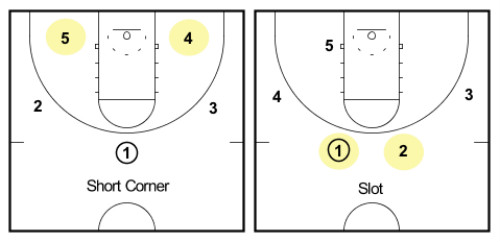
Small Forward – Also known as the ‘3’. One of the five positions on the court. Small forwards are known for their versatility as they’re able to contribute in multiple areas. They’re able to rebound the basketball while also capable of dribbling the basketball up the court if necessary.
Split Line – An imaginary line that extends from one basket to the other directly down the middle of the court. This is a useful line to refer to when coaching the defensive end of the floor.
Strong Side – When splitting the court in half vertically (basket to basket), the strong side is the side of the court the basketball is located on.
Spacing – A term you’ll often hear coaches say when they believe their players are too close together on offense. Great spacing is when all offensive players are 15 – 18 feet from each other.
Spin Dribble – An advanced dribbling move involving the player with the basketball reversing their body 360 degrees. This allows the dribbler to keep their body between the basketball and their defender.
Square Up – When a player catches the basketball on the perimeter, they ‘square up’ to the hoop by turning so that their feet, hips, and shoulders are aligned. This puts them in the position to shoot, pass, or dribble at any moment.
Staggered Screen – A staggered screen occurs when two players set off-ball screens for one of their teammates. The two screeners are positioned facing the same direction but not next to each other.
Steal – The basketball term steal is used when a player forces a turnover from an opponent by taking the basketball from them or deflecting a pass.
Stride Stop – A variation of the jump stop. But instead of both feet touching the ground simultaneously, in a stride stop one foot hits the ground before the other.
Substitution – When a player who was off the court swaps with a player on the court, it’s called a substitution. A ‘sub’ for short.
Swish – The term swish is used when a player makes a shot that doesn’t hit anything except the net.
Switch – A defensive strategy usually occurring when a screen is set that involves two defensive players swapping which player they’re guarding.
— T —
Tear Drop – See ‘floater’.
Technical Foul – A technical foul is called when a coach or player brings the game of basketball into disrepute and is not made in relation to contact. This could be actions like yelling at a referee, flopping, kicking a basketball, using inappropriate language, holding onto the rim after a dunk, etc.
Three-Pointer – As the name suggests, a three-pointer is worth three points and is a field goal from behind the three-point line.
Three-Point Line – The three-point line is an arc at each end of a basketball court surrounding each hoop. The distance of this line will vary depending on the level of basketball played (between 19 and 24 feet) but all shots taken from behind the three-point line are worth three points.
Three-Point Play – A three-point play is when a player scores a two-point basket while being fouled. They then go to the free-throw line and if they make the bonus free-throw it’s called a three-point play.
Through-the-Legs Dribble – An advanced dribbling move involving a player moving the basketball from one hand to the other by bouncing it between their legs. This is a great way to keep the basketball protected from your opponent while changing directions.
Throw In – The process of passing the basketball from out of bounds into the court.
Timeout – Coaches have a certain number of timeouts per quarter or half depending on the league their coaching in. Timeouts are used to rest players, motivate the team, make substitutions, change strategy, etc.
Tip-Off – The jump ball that starts every basketball game.
Top of the Key – The area above the three-point line in the middle of the court and closest to the half-way line. This is an important spot to keep filled in most offenses.
Trailer – An offensive player who plays behind the basketball as it’s been advanced up the court. This player is usually one of the post players and should always be in position for a safety pass across court if the point guard gets trapped.
Transition – The term ‘transition’ is used to describe the movement from offense to defense or defense to offense after a change of possession.
Trap – Refer to ‘Double Team’.
Travel – A traveling violation is difficult to describe in writing, but is in place to prevent players from taking more than one step while holding the basketball. This rule also prevents players from moving or changing their pivot foot once it’s been established.
Triangle and Two – A defensive strategy used against teams with two dominant players. This defense involves playing two defenders man-to-man and then creating a triangle zone with the three other defenders.
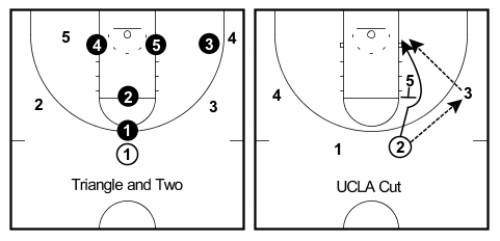
Triangle Offense – The triangle offense is a continuity basketball offense that combines perfect spacing with a series of actions based on player decisions resulting in a beautiful basketball offensive system.
Triple Double – The word ‘triple-double’ is used when a player scores in double-digits in three positive statistical categories. For example, 21 points, 11 rebounds, and 10 assists.
Turnover – A turnover occurs when a players loses possession of the basketball before a shot attempt. This most often occurs due to a poor pass or a violation.
— U —
UCLA Cut – A UCLA cut involves a player on the perimeter making a pass to the wing and then cutting to the strong-side block off a screen on the high post (elbow).
UCLA Screen – The UCLA screen is the back screen that allows a perimeter player to perform a UCLA cut. This screen is set on the elbow of the high post.
Up-and-Under – An offensive low post move involving a post player with their back to the basket faking a turnaround jump shot and then stepping in for the layup when the defender leaves their feet.
— V —
V-Cut – A v-cut is the most common type of cut used to get open on the perimeter. It involves a player cutting inside the three-point line, planting their foot, and then exploding back out to the perimeter to receive a pass or fill an open spot.
Violation – An infraction of the rules that isn’t a foul. This will usually be called against the team on offense and results in a loss of possession. For example, a double-dribble violation or a 5-second violation.
— W —
Weak Side – The side of the court opposite of where the basketball is currently located.
Wing – An area of the court located at the intersection of free-throw line extended and the three-point line.
WNBA – The Women’s National Basketball Association is a professional basketball league located in North America. The league consists of 12 teams and features many of the best female basketball players on the planet.
— Z —
Zipper Cut – A ‘zipper cut’ is a cut made by a player from the low block straight up to the slot area behind the three-point line.
Zone – A defensive strategy coaches will use that require defenders to guard specific areas of the court instead of opposition players.
And that’s it!
If there are any basketball terms you want the definition of that aren’t listed above, make a request in the comment section below and I’ll add it to the list.

